Continuing the ongoing series of interviews with creative artists working on various aspects of movie and TV productions, it is my pleasure to welcome Christopher Ross. In this interview he talks about the beginning of his career and technical changes in the last 15 years as the industry has shifted from film to digital, the various facets of cinematographer’s responsibilities on and off the set, and on what still surprises him in his chosen profession. Around these topics and more, Christopher dives deep into his work on the post-apocalyptic neo-noir world of last year’s “Terminal”, a story of deceit, betrayal and vengeance that stars Margot Robbie, Simon Pegg and Mike Myers.
Kirill: Please tell us about yourself and your path so far.
Christopher: I’ve been actively employed as a cinematographer since about 2007, but prior to that I’ve been an unemployed one, going back to 2000 when I started doing my first short film.
When I went to the university in mid-90s, I wanted to be a director. At the time I didn’t know that there was anyone else involved in making films, except for the director, the writers and the producers. When I was at the university studying physics, I worked alongside some writers who wanted to direct the same as me. Through the process of osmosis, I ended up being the cameraman for most of those other directors, shooting on VHS tapes.
After university, I started working in the film industry as a driver for various rental companies. That’s when I realized that there was this role of cinematographer that I could aim towards. It took about a decade to go from being an unemployed cinematographer to an employed one, and then another decade to work out where to go next.
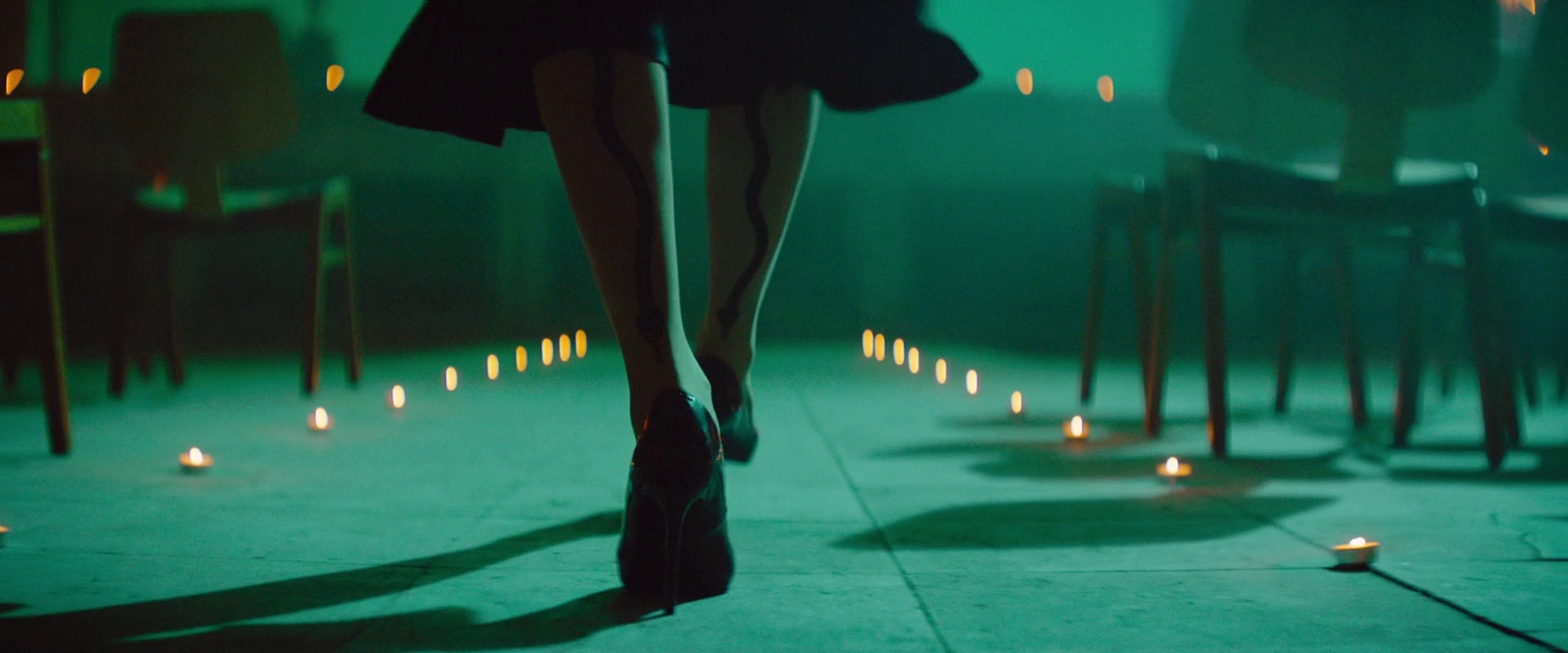
Kirill: Looking back at the last 15 years or so from the technical perspective, do you think it’s becoming easier to get into the field as the equipment is much more affordable these days?
Christopher: It’s a complex scenario. Speaking from my experience, when I first began working in the industry trying to become a cinematographer, the equipment that was trusted by the producers and the industry itself was 16mm and 35mm film. The only way for you to be given the role of the cinematographer on a budgeted motion picture of any kind was to show a great deal of experience with celluloid.
That was the difficult thing. You had to find somebody who had one of those cameras and borrow it, or rent it for a period of time, and then pay for the stock. It was a very expensive way of proving yourself. I worked with directors that wanted to push their short films as high as they could, and we ended up generally going 50/50. I would get hired to do a job, and I would use money from my day job to supplement making short films, in the hope that it would give me enough experience.
But today you can buy a digital SLR that records 4K video, with an SQN mixer and some stereo sound equipment. The access to technology is far higher, but there is another difference.
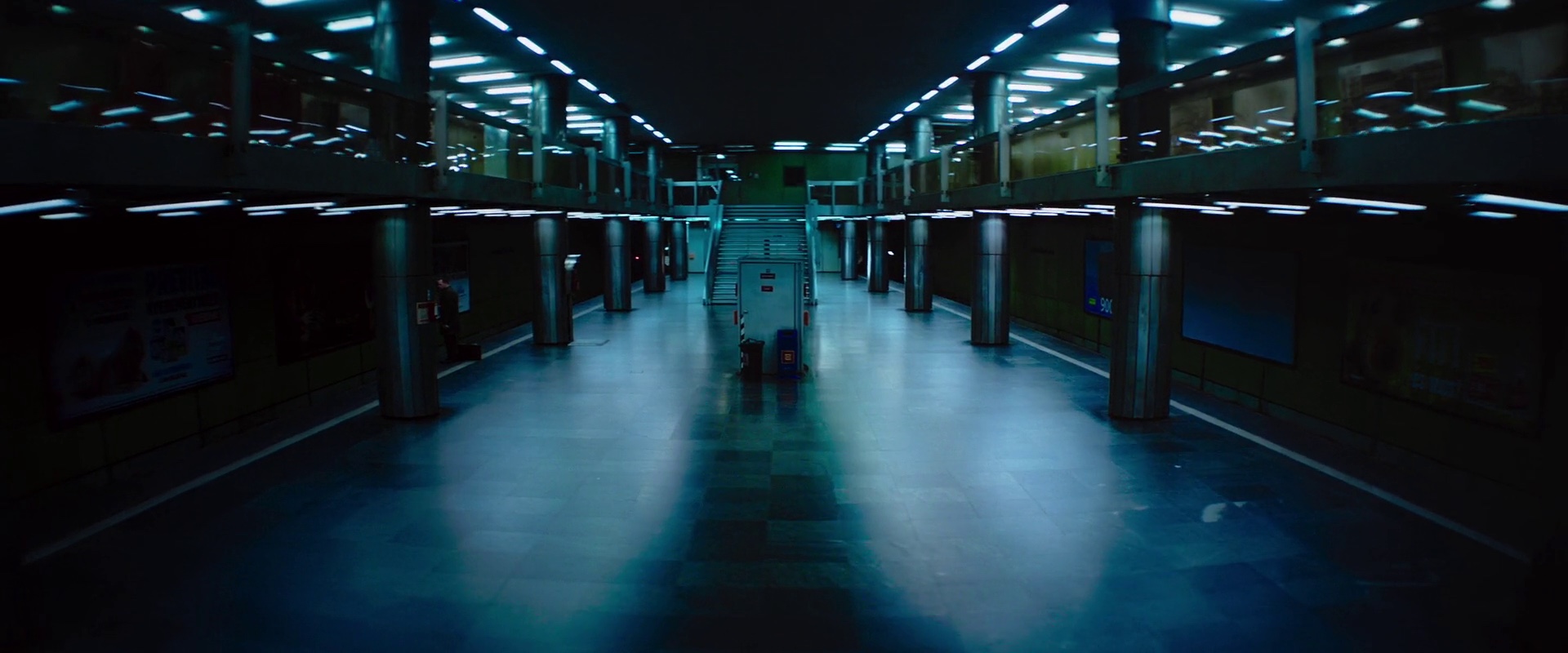
When I began, you were shooting on 100 or 200 ASA film stock. You had to light interiors, and now you don’t have to do it if you don’t want to. You can effectively shoot your films without putting forth yourself into the material. And if your self doesn’t come over in the material, that’s what the producers and the directors are going to see. They want to see what you brought to the thing.
Actually, I’d say that it’s much harder these days to make yourself any different to 200 other aspiring cinematographers of all ages that are trying to make their way. But when I was younger, you still had to stand above others in order to be seen.
The one thing that I would say about the advent of digital cinema is that has allowed filmmakers to take far bigger risks in the worlds of short film and music videos. There’s a safety net of digital that allows you to be much more experimental, in a knowingly-successful way, whereas previously you had the fear of celluloid on your back.
Continue reading »
There’s a lot of hand-wringing around the changes Verizon corporate is bringing down on the Tumblr communities. People are talking about the freedom of creative expression, the future of safe spaces for fringe interests and the good old days before the engagement-driven ad “opportunities”. Yahoo’s billion-dollar purchase of the not-quite profitable platform was accompanied by grand promises:
We promise not to screw it up. Tumblr is incredibly special and has a great thing going. We will operate Tumblr independently. David Karp will remain CEO. The product roadmap, their team, their wit and irreverence will all remain the same as will their mission to empower creators to make their best work and get it in front of the audience they deserve. Yahoo! will help Tumblr get even better, faster.
…
In terms of working together, Tumblr can deploy Yahoo!’s personalization technology and search infrastructure to help its users discover creators, bloggers, and content they’ll love. In turn, Tumblr brings 50 billion blog posts (and 75 million more arriving each day) to Yahoo!’s media network and search experiences. The two companies will also work together to create advertising opportunities that are seamless and enhance user experience.
There’s a certain beauty in the natural cycles of web chaos. And there’s also a big difference between sustained and sustainable. The history so far has shown that it is not a sustainable endeavor to build a popular social platform that is held in high esteem by both users and the market forces. It’s a rather awkward place between being a sustained loss center, and being stuck in a somewhat unsavory self-reinforcing cycle of business decisions that go counter to the whole notion of, well, social.
As for me, with the impending shuttering of Google+, I’ll be writing more right here in my own little web garden.
Software is never quite done. Even if you have all the features put in, and all the known bugs fixed, if you stand still, the world will slowly pass you by and leave you behind.
A modern app is, more or less, expected to be everywhere. People expect seamless sync between all their devices, intelligent offline, presence of all the screens in their life, and constant adaptation of how the app behaves to the ever-evolving world of technology that we live in.
The same goes for web sites. Space Jam is a rather wonderful memento of the early web frozen in time. But it’s a curiosity, a rare peek into the world of yesteryear.
Content is king they say. Whoever they are, they don’t tell you that the presentation of content matters. As I was switching my site to be fully HTTPS earlier in the year, I was reminiscing on all the non-content maintenance work that I keep on doing on a semi-regular basis with my site to keep up with the latest and greatest. To keep up with what is “expected” of modern web sites. To get a feel of the burden the technology evolution is placing on hundreds of thousands (millions, tens of millions?) of web developers that find their carefully constructed houses of cards gather cobwebs.
- In 2012 I’ve switched to using web fonts, and I kept on tweaking those ever since – for body, headings and navigational elements.
- In 2013 I’ve switched to fully responsive design, scaling the overall layout to behave well on a variety of screen sizes.
- In 2014 I’ve switched to use 2x / retina images on relevant hardware, which required going back to the archives and resourcing all the images in the interviews that have been published until then.
- In 2015 I’ve switched to a single-column layout, rearranging the content to flow better across a variety of screens.
- In 2018 I’ve switched to HTTPS, even though the only user-facing input box is the search tucked at the very end of the page.
Is the latest 3 year gap an indication that things are slowing down? Maybe. But probably not. I’m still tending this little web garden of mine. The latest chapter, so far, has been adding support for dark mode:
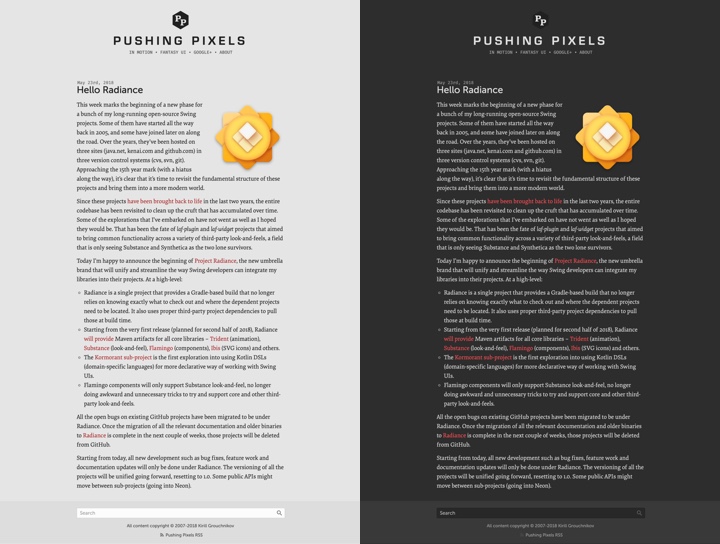
On the left is the regular version of Pushing Pixels. On the right is how it looks like running under Safari Technology Preview on the latest macOS 10.14.1 (Mojave), with the work under way to add the matching CSS selector support to Firefox and Chrome.
I hope this little web garden of mine will be there in 10 years. In 20 years. Hopefully in 40 years. There’s a lot of tending ahead.
Note: since this post was written, Safari for macOS 10.14.4+ and Firefox 67+ have added official support for dark mode. Chrome has added support for dark mode starting in 73 on Mac and starting in 74 on Windows.
Continuing the ongoing series of interviews with creative artists working on various aspects of movie and TV productions, it is my pleasure to welcome Richard Hoover. In this interview he talks about the changes technology has brought to the world of art department in recent years, the meaning of success and the business side of the industry, and collaborating with directors and cinematographers on finding the right visuals for the story. Around these topics and more, Richard goes back to his work on “Twin Peaks” and “Girl Interrupted”, and dives deep into building the worlds of the upcoming family drama “Second Act” – out in theaters this December.

Kirill: Please tell us about yourself and what brought you to the world of storytelling.
Richard: I found the theater first and, of course, was an actor. In school I began designing stage sets and making plays. I think storytelling is a desire that grew and is being realized – as opposed to being in my mind at the beginning. Over recent years I’ve grown in the desire to learn the basics of storytelling, visually and verbally. I want now to know not only structure and construct, but also of what value story may have for others, for the audience, and how does it reflect a truth.
That interest had grown out of making scenery on stage. I still like building and making things. These days it is actually more critical that I use more of verbal muscle through writing.
Kirill: From your perspective, how has the world of storytelling evolved in the last 30-35 years since you started?
Richard: I think there have been advances but still story is still rooted in the basic human soul. We have an inherent need to tell stories, the desire to tell and to connect. In terms of story in film language there have been leaping advances in pacing and scope that are fascinating. “Twin Peaks”, for example, used a slowed down pace, wide angle shots, and a humorous witnessing that was very radical for TV at that time.
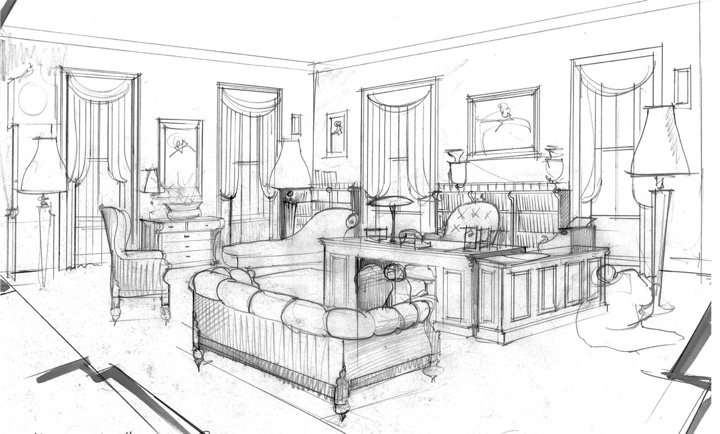
Sketch art for “Girl Interrupted”, courtesy of Richard Hoover.
Concerning the growth in digital infrastructure that has been happening in the last 20-25 years, there are now chances to do things in a virtual way not previously available. We used to build physical models, and now we do it digitally (as well as physically). We can look at it from all sides, explore it and figure out if we want to adjust things. That has become a major advance in what I have to do as a designer of a production. The digital world to me is both wonderful and painful in that it has also speeded us up and invaded quiet times.
We have less time now in film productions, and the economical pressure is more intense. So story is traded in often too speeded up a way. Communication has sped up, and sometimes in that speed-up things get lost. You sit in the same office with somebody, and you keep on emailing each other. I need to go stand in the room, and talk and show. That being said, if you’re working in a remote place, digital links are an advantage. You can send images, and that’s been amazing.
I remember my first cell phone which was this giant banana [laughs], and before that it was quarters in the pocket and payphones if you could find them.
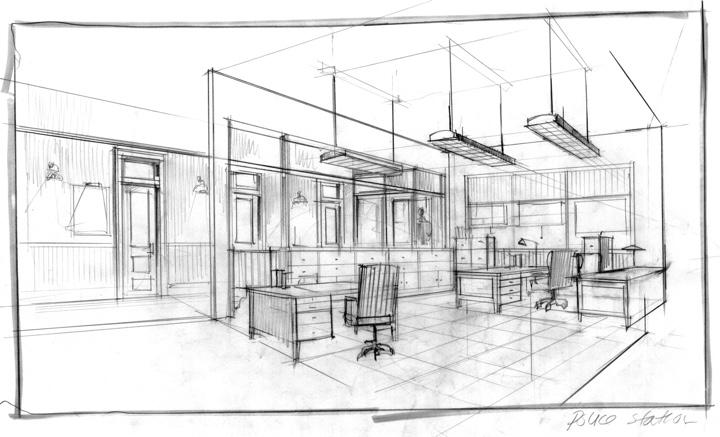
Sketch art for “Girl Interrupted”, courtesy of Richard Hoover.
It is amazing, but it still takes time and economical investment to get the technical people in place to help the designer illustrate and render. The key thing is interactive presentation to the director and the producers, so that there’s a sense of a commitment to tone and approach. During those presentations it’s critical to have digital tools and physical tools to really look at how things are going to want to be – as a hope, as a desire. That’s what I always try to do. If I have an illustrator, that’s a wonderful thing. If I have time to do it, I’ll do it in pencil or in Photoshop. It doesn’t happen in a moment though. It takes hours.
Kirill: What about how much the modern cameras can capture as far as the resolution goes? Do you find that your sets need to be more detailed?
Richard: High definition digital cameras have pushed change in design a lot. So much more can be seen now, and details might become much more of an issue than in normal film camera work.
I do find it very interesting to see how little lighting is needed these days. Sometimes I watch a film on my computer, and it’s all dark, but that’s fine. But it’s amazing to see what can be done with just a candle in the room.
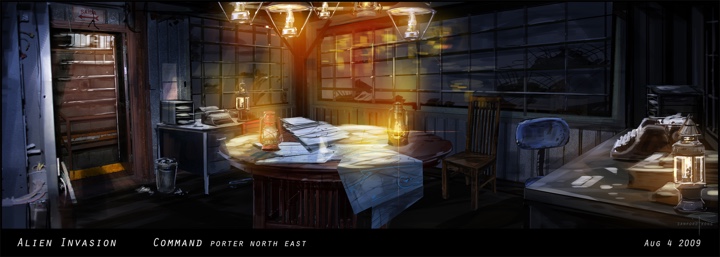
Concept art for “Falling Skies”, courtesy of Richard Hoover.
Continue reading »
![]()
![]()